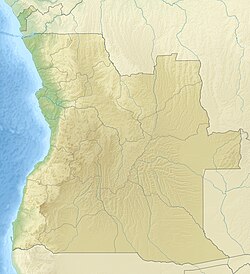
Adamastor is a mythological character created by the Portuguese poet Luís de Camões in his epic poem Os Lusíadas, as a personification of the Cape of Good Hope, symbolizing the dangers of the sea and the formidable forces of nature challenged and ultimately overcome by the Portuguese during the Age of Discovery. Adamastor manifests itself out of a storm.

Octávio Mateus is a Portuguese dinosaur paleontologist and biologist Professor of Paleontology at the Faculdade de Ciências e Tecnologia da Universidade Nova de Lisboa. He graduated in Universidade de Évora and received his PhD at Universidade Nova de Lisboa in 2005. He collaborates with Museu da Lourinhã, known for their dinosaur collection.
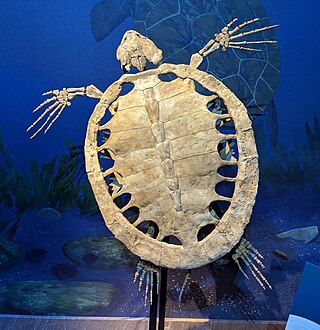
Euclastes is an extinct genus of sea turtles that survived the Cretaceous–Paleogene mass extinction. The genus was first named by Edward Drinker Cope in 1867, and contains three species. E. hutchisoni, was named in 2003 but has since been reassigned to the genus Pacifichelys, while E. coahuilaensis named in 2009 was reassigned as Mexichelys coahuilaensis in 2010.

Nyctosauridae is a family of specialized soaring pterosaurs of the late Cretaceous Period of North America, Africa, and possibly Europe. It was named in 1889 by Henry Alleyne Nicholson and Richard Lydekker.

Angolachelys is an extinct genus of African marine turtle which existed in Angola during the Turonian stage of the Late Cretaceous. The type species is Angolachelys mbaxi. The type MGUAN-PA includes skull, jaw, and postcranial fragments found in the Tadi Beds of the Itombe Formation.

Pteranodontia is an extinct group of ornithocheiroid pterodactyloid pterosaurs that lived during the Late Cretaceous period of North America and Africa. They were some of the most advanced pterosaurs, and possessed highly specialized cranial crests that may have served as sexual attraction, with males having a much larger crest.

Angolatitan is a genus of titanosauriform sauropod dinosaur from the Upper Cretaceous. It is also the first non-avian dinosaur discovered in Angola. The genus contains a single species, Angolatitan adamastor, known from a partial right forelimb. Angolatitan was a relict form of its time; it was a Late Cretaceous basal titanosauriform, when more derived titanosaurs were far more common.

The geology of Angola includes large areas of Precambrian age rocks. The west of the country is characterized by meta-sedimentary rocks of Proterozoic age including tillites assigned to the Bembe System. Overlying these are a thick pile of limestones and other marine sediments laid down during the Mesozoic and Cenozoic eras. Amidst the Proterozoic sequence are areas of crystalline basement dating from the Archaean. More Archaean basement rocks form the Kasai Craton in northeastern Angola. In the north, within the Cassanje Graben are clastic sediments and volcanic rocks of the Karoo Supergroup. Kimberlites and carbonatites resulting from magmatic activity during the Karoo period are found along a northeast-southwest line through the country. Continental sediments of the Kalahari Group are widespread in eastern Angola.
The Bentiaba is a river in southern Angola. Its mouth is at the Atlantic Ocean near the commune of Bentiaba in Namibe Province.

Cardiocorax is an extinct genus of elasmosaurid known from the Late Cretaceous Mocuio Formation of Namibe Province, southern Angola. It contains a single species, Cardiocorax mukulu.

Alcione is a genus of pterosaur from the Ouled Abdoun Basin of Morocco, dating back to the Maastrichtian stage of the Late Cretaceous period. Only one species, A. elainus, is known. This pterosaur lived in a marine environment alongside several other pterosaurs, including Simurghia and Barbaridactylus.
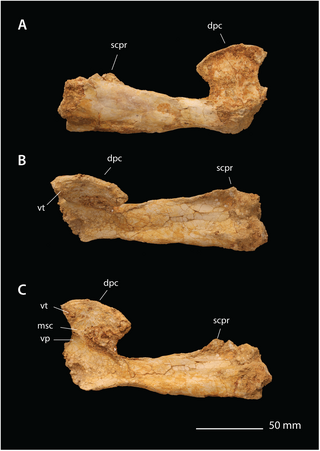
Simurghia is a genus of pterosaur from the Ouled Abdoun Basin of Morocco, a basin that dates to the Maastrichtian stage of the Late Cretaceous period, about 66 million years ago. It was published in 2018 by paleontologists Nicholas R. Longrich, David M. Martill, and Brian Andres, along with two other pterosaurs from the same basin: Alcione and Barbaridactylus. The type and only species is S. robusta.
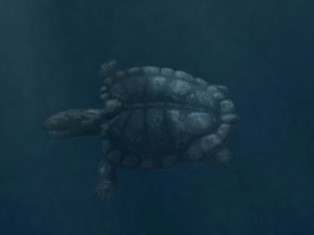
Angolachelonia is a clade of extinct turtles from the Late Jurassic to Paleogene of Eurasia. The group is defined as all taxa derived from the ancestor of the type genus Angolachelys and Solnhofia, a definition that could potentially encompass a clade of entirely marine turtles. Angolachelonia was originally inclusive of only Solnhofia, Angolachelys and Sandownia when originally conceived by Octavio Mateus and colleagues in 2009, but later phylogenetic analyses by Serjocha Evers and Roger Benson in 2018 unites the family Sandownidae, including Angolachelys and Sandownia among other taxa, with the entirely Late Jurassic clade Thalassochelydia, where Solnhofia may be a basal member. While the placement of Solnhofia is weak and the clade that Angolachelonia represents may change with further analysis, the clade of Sandownidae and Thalassochelydia is well-supported, and does not collapse despite the uncertain evolutionary history of the group. Three alternative potential origins of Angolachelonia sensu Evers and Benson are shown below.
Calcarichelys is an extinct genus of protostegid turtle from the Late Cretaceous of the Selma Formation in Alabama, and possibly from Angola. It contains only one species, C. gemma.
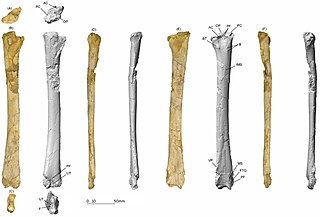
Epapatelo is a genus of pteranodontian pterosaur from the late Cretaceous Mocuio Formation of Namibe Province, Angola. The genus contains a single species, E. otyikokolo, known from partial left limb bones.
The Mocuio Formation is a Late Cretaceous sedimentary rock formation found in southern Angola. It extends from the latest Campanian to the Early Maastrichtian. Many vertebrate fossils have been collected from the formation.
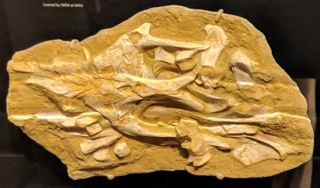
Bentiabasaurus is an extinct genus of mosasaur from the Late Cretaceous Mocuio Formation of Angola. The type and only species of the genus, B. jacobsi, was described in 2023 by Michael Polcyn, Anne Schulp and António Gonçalves. The animal is known from a partial skeleton, including parts of the skull and mandibles, alongside a number of vertebrae and ribs. The syntypes were recovered from the Bench 19 Bonebed near Bentiaba, Angola. The genus name is a combination of the name Bentiaba, the place near which it was found, and the Ancient Greek σαῦρος. The species name, jacobsi, refers to Professor Louis L. Jacobs, in honor of his contributions to African vertebrate paleontology.
